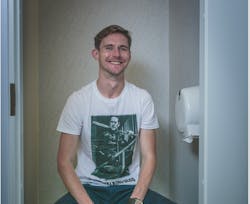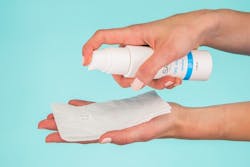A Greener Alternative to Wet Wipes
Sara Myers is associate editor for WWD. Myers can be reached at [email protected] or 847.391.1007.
In Estonia, a new product has become the go-to as an alternative to wet wipes. Satu Laboratory sells “gel wipes” as a better and greener way to wipe your bottom. The “wipe” is a gel you can apply to toilet paper before use.
The product was evaluated by Intertek, a worldwide group of testing laboratories for the textile, footwear, toys, petroleum and chemicals industries. The moisturizer is suitable for children under three years old. Tests were made to evaluate the environmental impact and the gel was approved for flushing. It is currently the number one toilet paper moisturizer in the U.K. and the product appeared in Forbes in June.
WWD Associate Editor Sara Myers spoke to Siim Saat, CEO of Satu Laboratory, about his company, the gel wipes and the flushable wet wipes epidemic.
Sara Myers: Can you tell me more about your company and what you do?
Siim Saat: It’s quite simple. We are an Estonian startup. We manufacture and sell gel wipes. It’s a toilet paper moisturizer that you just put on regular toilet paper and you can clean your bottom with it. And, it’s an upgrade or alternative for flushable wet wipes.
Myers: What is in the special formula and what makes it so environmentally friendly?
Saat: It is 88% water, Triethanolamine, Panthenol, Ethylparaben, and more. You know there is a huge problem with flushable wet wipes. The wipes have liquid plastics in the gel so it won’t ruin them. Our product is environmentally friendly because it doesn’t contain any liquid plastic and it dissolves quickly. Usually toilet paper when flushed it takes roughly five minutes. [The gel] doesn’t make that process any longer. No clorox, no problems. And, that’s basically it.
Also, we produce it in Europe. Compared to other wet wipe manufacturers that come from China, our product life cycle is greener because the transportation of our products doesn’t pollute the environment because we produce it locally in Europe. At one point, we were thinking of opening or finding a production partner in North America. So, our life cycle for our North American customers would also be greener. Because right now we send the products through a warehouse, that we must add the transport pollution from Europe in that cycle. We are monitoring every aspect of our product because we want to make it as green as possible.
Saat: Are the gel wipes the only product your company sells right now?
Myers: We are focusing only on the gel wipe. But maybe in the future we also will start producing toilet paper if we find a trustworthy partner who agrees with our environmental goals. In Spain, we are actually in cooperation with one of Spain’s largest toilet paper manufacturers. They have combined packages of eight rolls of toilet paper and a bottle of our gel wipes. Right now, we are only selling through pharmacies.
Saat: On the top of your site I noticed you have a changing number of wet wipes being saved from oceans and sewers. How exactly is that number calculated?
Myers: It’s actually quite simple. We can monitor our sales through Amazon and the average bottle sold in pharmacies. And, we already know that our bottle is 100 ml. It equals about 600 wet wipes because the average adult going to the loo nowadays is 3 to 4 wet wipes plus toilet paper. One wipe with the gel wipes usually equals about 3 to 4 wet wipes.
Myers: Anything else you would like to add?
Saat: Wet wipes around the world are losing legal battles. In Australia, basically every case that has been taken to court has lost. In Europe, things are also changing. But, in the states [U.S.], it’s quite weird. Last time I read some court documents on it I wasn’t sure if I should laugh or cry. The court was in Washington D.C., and basically they decided the wet wipes weren’t actually flushable but we can’t do anything because you are the only company standing in front of us and it would be an unfair market situation for you if we say that your product is not flushable. For me, from a European court experience, it was really interesting.
Editor’s Note: Saat later sent the rest of the ingredients of the product, they include: Alcohol, PEG-40, Hydrogenated Castor Oil, Propylene Glycol, Allantoin, Tocopheryl Acetate, Carbomer. Ethylhexylglycerin, Triethanolamine, Imidazolidinyl Urea, Phenoxyethanol and Methylparaben.

